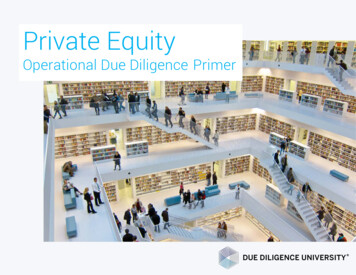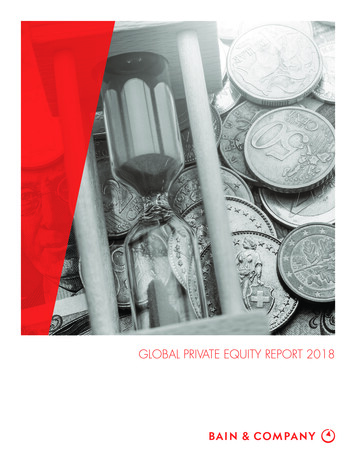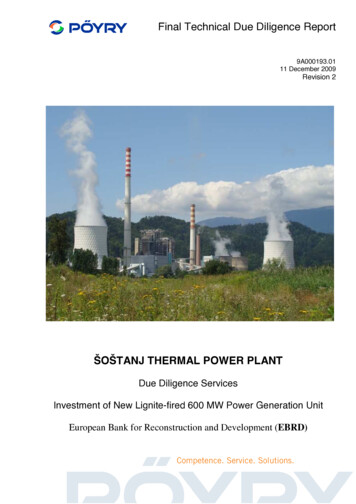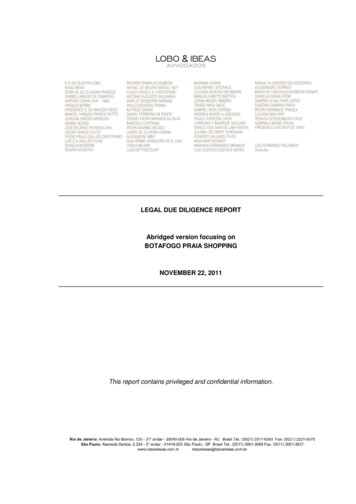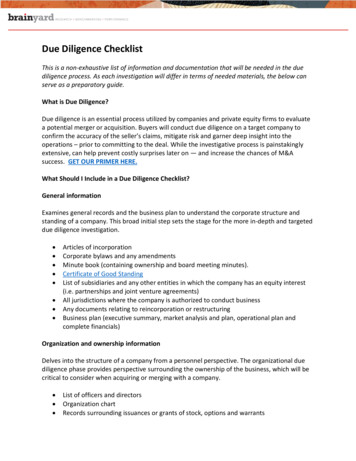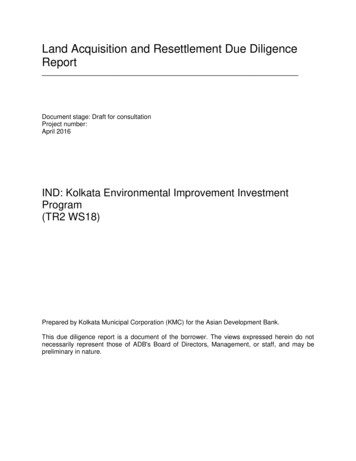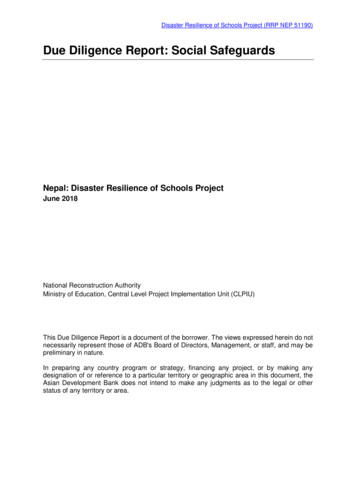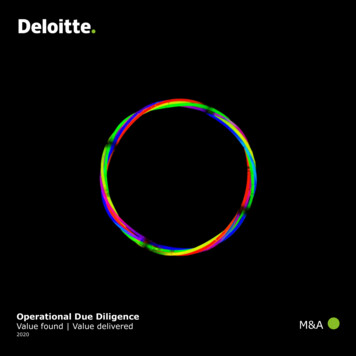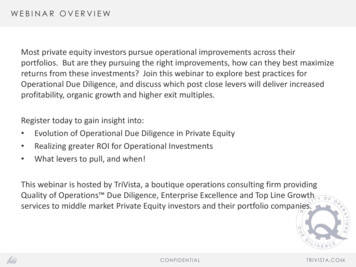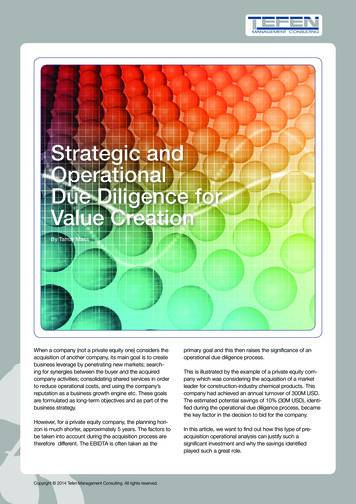
Transcription
Strategic andOperationalDue Diligence forValue CreationBy Tamar MassWhen a company (not a private equity one) considers theacquisition of another company, its main goal is to createbusiness leverage by penetrating new markets; searching for synergies between the buyer and the acquiredcompany activities; consolidating shared services in orderto reduce operational costs, and using the company’sreputation as a business growth engine etc. These goalsare formulated as long-term objectives and as part of thebusiness strategy.However, for a private equity company, the planning horizon is much shorter, approximately 5 years. The factors tobe taken into account during the acquisition process aretherefore different. The EBIDTA is often taken as theCopyright 2014 Tefen Management Consulting. All rights reserved.primary goal and this then raises the significance of anoperational due diligence process.This is illustrated by the example of a private equity company which was considering the acquisition of a marketleader for construction-industry chemical products. Thiscompany had achieved an annual turnover of 300M USD.The estimated potential savings of 10% (30M USD), identified during the operational due diligence process, becamethe key factor in the decision to bid for the company.In this article, we want to find out how this type of preacquisition operational analysis can justify such asignificant investment and why the savings identifiedplayed such a great role.
So what exactly is operationaldue diligence?So how can we improve the EBIDTA ofthe acquired company?When a company considers buying another companywithin its own industry, the role of due diligence is mainlyto verify the data and information provided by the acquiredcompany. The acquiring company uses its experience andknowhow of the relevant market, plus the verified data, toassess the expected impact of the acquisition on its valuecurve.Growth in income – the main drawback of this is thelack of certainty. A company’s income depends not onlyon internal factors, but also on external factors such ascustomers, competitors and market behavior.Cost reduction – depends primarily on internal factors,meaning that the level of certainty is much higher.An operational due diligence process that manages todefine an applicable plan for significantly increasing theEBIDTA will make a substantial contribution to the privateequity’s decision to acquire the company.PerformanceHighrelativeValue ofOffering“Starting the process”Stage 1:“Rough and Dirty” - Getting to know the organizationLowABCDEFGKey Competitive FactorsAs mentioned above, the benefits of the acquisition arenot necessarily planned for the short term.Private equity companies, in contrast, also use due diligence to assess the growth potential in EBIDTA (achievednot by synergy and mergers but from stand-alone performance optimization), with a view to gaining a significantlyhigher sales value by the time of their exit (timeframe of5-8 years). Those private equities specializing in assetmanagement, rather than “turnaround” transactions, placean even greater emphasis on a successful due diligenceprocess.Although we have seen that the main focus is on deriving value from growth, reality does not always meet theseexpectations. Therefore, in the short-term (investmentperiod), it is much more predictable to aim for cost benefits through operational improvements than for growththrough revenue increase. Business development is oftenunpredictable and depends not only on a company’s behavior or decisions. It is significantly influenced by markettrends, consumer preferences and competitors’ behavior.Moreover, cost savings through operational improvement are the easiest way to inject cash into the portfoliocompany. This cash can then be used for growth-relatedinvestments.Operational improvements also have an immediate impacton the organization’s “bottom line”. The implementation ofsuch improvements is controlled by the company, so it iseasy to quantify the savings potential with high certainty(regardless of the variability in the market).Copyright 2014 Tefen Management Consulting. All rights reserved.Stage 2:Exploring the organization’s business environment and itsoperational and business processesStage 3:Performing an analysis of the core activitiesStage 4:OutputsStage 1: “Rough and Dirty” – Getting to know theorganizationThe aim of the first phase is to study the organization’smain activities and to identify its key contribution torevenue and expenses. This phase helps to define theobjectives and scope of the diagnostic process.Tools and methods used in the 1st stage:Cost structure analysis – identify operating segmentswith high costs for the project’s focusInternal benchmark (between sites) – identify “bestin class” in different categories and examine theimplications of bringing others to this levelStage 2: Exploring the organization’s business environment and its operational and business processesThe second stage focuses mainly on learning the businessenvironment, current market share, growth potential andcompetitors’ behavior.
Tools and methods used in the 2nd stage:Market analysis – market share, market demandtrends, competitors analysisOrganizational structure analysisS&OPInventory and procurement management methodsBrand power – consumers perceptions,TOM awarenessTrends – category trends, price trendsSales – sales processes, sales policy – SFE*, Customersegmentation, SKU rationalization (volume & profit),returns volume and policiesStage 3: Performing an analysis of the core activitiesThe 3rd phase is a thorough analysis of the core activitiesin the organization, in order to identify potential savings,opportunities for improving efficiency and required investmentsProcurementProcurement processes (centralized / decentralized)Inventory levelsContracts with subcontractors and suppliersexaminationBottlenecks identificationManpower standardization – organizational structure& manager-employees ratioOperational excellence (OPEX)Supply ChainHaulage & distribution efficiency(scheduling methodology etc.)Driver payment methodsTrucks maintenanceLoading and unloading processesQualityWasteQA infrastructure and processesQuality control proceduresLean & 6 sigmaTools and methods used in the 3rd stage areobservations, interviews, benchmark analysis andrisks analysisManufacturingManufacturing processesValue stream mappingCrusherOvenPlaster MinePlasterMinePlasterStonesCrusherOvenCapacity modelCopyright 2014 Tefen Management Consulting. All rights reserved.BoardProductionGrinderGrinderproduces ingOther MaterialsBlender
Stage 4: Outputs – examples of tools for final analysisTraditionally, strategic acquisition requires a financial andbusiness due diligence regarding market share, trends anddifferent forecasts. This claims to predict a company’s status over the short and long term. However, the main drawback in the traditional financial/business due diligence isthe high level of uncertainty in its findings and inferences.Private equities seeking to acquire a company must beexposed to reliable, high-confidence information regardingthe organization’s capabilities, quality and operationalabilities and drawbacks. This applies both to the currentstate of the company and its ability to support futurecapacities set according to the company’s businessstrategic plan for growth. In addition, potential buyersmust take into consideration required investments,business and operational opportunities etc.Tamar Mass, Senior Consultant, Tefen IsraelCopyright 2014 Tefen Management Consulting. All rights reserved.
ProcurementOptimization –How to “Getmore Bangfor yourBuck”By Valentina Vassilev,Saverio Russo andSi PengProcurement Revisited“We are earning big bucks for doing almost nothing”.You might have heard this in the last century when manycompanies invested little effort and still achieved “rocket”sales. However, this is hardly the case in the currenteconomy. Sustainable sales growth is increasingly perceived to be a major bottleneck in corporations. Businesssuccess and even survival requires a much more tangiblemanagerial focus on costs, sometimes with the urgency ofshort time horizons. As various cost-cutting initiatives become the norm, the challenge is how to “get more bangfor every buck ” invested on such initiative. One of themost efficient and impactful cost reduction levers remainsprocurement optimization. In many cases,Copyright 2014 Tefen Management Consulting. All rights reserved.PE firms invest in mid-market companies whose size, history and managerial background do not usually guaranteethe highest standards in terms of procurement practices.Procurement is a cross-functional process, which cansignificantly impact bottom line performance, and onwhich it is important to have a “steady grip”.Over a period of 4-6 months, a procurement optimizationprogram can deliver a quick but tangible P&L improvement and enhance the agility of the procurement process,which makes it one of the preferred levers amongst PEfirms, particularly in the 2nd half of the investment horizonfor growth deals. A target of 8-12% reduction in annualspend on goods and services is reasonable and achievable with fast, traceable impact on P&L, and therefore onthe EBITDA.
SymptomsGoing beyond “Buy the Same for Less”Based on our experience, companies exhibiting one ormore of the following patterns often benefit significantlyfrom procurement optimization:Long-term relationships with few, local suppliersOrder fragmentation across many suppliers and/orover timeLack of internal technical specifications or overspecificationLow involvement in the buying process by users/limited control of the spending by the ProcurementdepartmentFragmented procurement functions across thecompany and buyers performing primarily secretarialrole/activitiesAbsence of formalized processes/procedures andlimits on authorizationAbsence of forecast and procurement plans periodic/rolling (re-)elaborationThe objective of a procurement optimization projectmay sound straight-forward – “buy the same for less”.However, it is never just about knuckling ten cents downwith the favorite supplier or getting more cash-back atthe end of the year. Instead, the project aims at realizingsaving potentials in the short-term while re-constructingan efficient procurement organization (including processesand systems/tools) that guarantees recurrent profits forthe longer term. Furthermore, the procurement optimization team needs to go far beyond the surface, reviewinginternal spending patterns and the causes of malpractice,and also analyzing the detailed specifications.When facing such context, the benefits of procurementinitiatives largely surpass the challenges related to theirexecution:Chart 1 – Benefits and challenges ofprocurement optimizationFocus on practical activities and renegotiations, not over-analyzing the spending base(Benefits) Less complex and faster in delivering EBITDAthan process reengineering or manufacturingefficiency; lower resistance than, for example,headcount reductionPositive and recurrent cash flow and EBITDAimpactImmediate implementation: signature of newcontracts, availability of updated price lists, etc.“Moving” of procurement levers that haveremained untapped after years of stronggrowth focusOptimization of specifications, towardsde-complexity, lean and innovationDevelopment of standardized tools, “readyto-use” templates and more accurate andconsistent databases(Challenges)–More time-consuming and requiring a higherlevel of commitment than other optimizationinitiatives (e.g. workforce reduction)Requires efforts to step outside of comfort zone– new suppliers and specs, new costs modeling, etc.Need to understand the dynamics acrossthe supply chain and gain insight into remotemarketsCommon goals of procurement initiatives are:Reduce the unitary cost of purchaseOptimize the amount of Net Working Capital (NWC) –stocks, payment termsReview the minimum/optimal necessity(demand/volumes) for materials, external services, etc.Looking for opportunities to simplify the portfolio ofprocured materials/servicesDefine, review and challenge technical productspecifications/service level agreementsShorten lead-times, particularly for “critical”componentsImprove/redesign processes (e.g. “core” supply chainand budgeting/cost control)Not all Spending Categories are CreatedEquallyIn an ideal world, the joint team will have good qualitydata of past spending in order to perform quality analysis,execute rapidly and promptly come back with the expected result. However, a more common reality is that oflimited data accessibility, lengthy data collection process,low data quality and difficulties experienced by staff whengathering information required for cross-checks, verifications and mistake explanation. Therefore, initial diagnosticsare often coupled with extensive data verification, reclassification and cleansing to accelerate the tendering processand guarantee quality output.Once we have clarity on spending buckets (baseline andpatterns) and the specific project goals are determined,the first step is to define the procurement strategiesand approach for each spending category identified.To structure an all-round procurement optimization project,5 groups of levers are commonly adopted1:1Copyright 2014 Tefen Management Consulting. All rights reserved.See the last page for more detailed description of improvement levers
Chart 2 – Main lever types and examplesTraditional ProcurementScout new suppliers and expand the bidders listNegotiate longer payment terms and discounts.Strategic Sourcing RelationshipsEliminate “spot” orders and set-upframe agreementsDevelop joint medium-term plans toenhance efficiency of both parties.MAINLEVERSBusiness Process ReviewCollect and share with Suppliers dataon future demand and try to aggregateorders over timeImplement periodic monitoring ofconsumption and recur to statisticalanalysis of spending Supply Chain RedesignReview “make or buy” decisionsAssess the possibility of tapping earlierinto the value chain/skip intermediaries.DemandManagementReview/standardize technical specificationsRationalize required quantities/SKUs/SLAs network would focus more on demand aggregation,review on specifications, and tender process standardization. Larger or more complex categories often requirea formalized tendering process with 2-3 rounds of negotiations, while small spending buckets could be tackledwith a “quick and dirty”, less formal tender or simpleorganizational adjustment (e.g. aggregate orders andappoint a central reference for small categories; eliminateunnecessary spending and corresponding roles, etc.).There is no “one size fits all” approach. Levers should becustomized in line with characteristics of each category,such as: size, purchasing pattern, industrial margins, degree of commoditization of purchased goods/services. Forexample, commodities management – including indexingand cost modeling – may be highly relevant for industrialmanufacturing companies where the procurement of metal(e.g. steel, copper) makes up the majority of the spending.However, a procurement optimization project for a hospitalChart 3 – Sample approach to procurement optimization231InitialScoping2Quick-hitsData collection &analysisData requirementsData extractiondefinitionAnalytical baselines definitionHigh level spending(extensive re-classificationbaseline understandinglikely)Commodities vs. valueDiagnostics, e.g.added goods/servicesSpending Map breakdownRecent optimizationsSuppliers’ ABCAs-Is procurementOrders frequency andapproachLead-timesPreliminary identificationBrainstorming with expertsof opportunitiesFocus Categories definition/Definition of the financialprioritizationtargetValidate list of opportunitiesto tackleImprovement leversimplementation &Tender execution4Market understandingFirst 1-o-1 contacts with SuppliersTenders preparationTechnical Specifications,Vendor Lists (incl. new suppliers)RFI, RFQIndexesOffers collection and negotiations(1 or 2 rounds)Technical verificationsContracts closingBenefits estimation and businesscase definitionFollow-up andmonitoringBenefits reconciliation withbudget/inclusion in financialforecastsDefinition of monitoringmechanisms andresponsibilitiesFirst monitoring of P&Limpact (actual vs. planned)andfollow-upsmark internally – find the innovators within and transferbest practice across the networkSource across the entire value chain, cutting earlierinto it. Remove as many of the middle-men aspossible. Consider “non-sources” from other industriesand new partnerships of mutual interest – for example,in food industries someone else’s waste is your rawmaterial, or they need only part of the product and youcan utilize the rest. Join forces in R&D with suppliersand synergistic non-competitorsBalance between aggressive price squeezing and longterm win-win partnership, which should be maintainedby inviting current suppliers to contribute with costsaving options on top of pricing (e.g. line audits,SKU rationalization, new specifications)There is no ready recipe for project execution in Procurement, but we have seen the following approaches workin many different industries:Ensure a thorough understanding of purchasing patterns in all locations and aim at maximum level ofvolume planning and aggregation that makes operational and financial sense (there could be instances whenlow volumes or irregular ordering do not merit volumeaggregation)Work closely with technical staff, quality and R&Ddepartments to simplify and optimize specification –there is always room for significant improvement andrisks are more often than not perceived instead of real.Test aggressively for new specifications and suppliers.Think outside the box – think about alternative materialsand applications, new recipe formulations, etc. BenchCopyright 2014 Tefen Management Consulting. All rights reserved.52Quick-hits refer to the opportunities that have a relatively large impact and can betackled quickly and easily. These are different from the secondary spending categories– small baseline and require more additional effort—which are tackled after the mainimprovement levers.
Carefully choose timing according to industry logicsand market trends (e.g. buying printing services andpaper needs to be done when the printing season/campaign is about to start, i.e. November)Preparation is half the game won – detailed dataanalysis (e.g. past spent, specifications, submittedoffers) and saving potential estimation prior tonegotiation being a key lever to successCompetition is good – invite new suppliers and makethe current suppliers aware that they are in competitivetender with international companiesBe sensitive when managing communication as certainmarkets may backfire. It is therefore important to knowthe landscape before you design tender strategy andbe specifically aware in markets with shortage ofsupply, oligopolies, etc.Not there until seen in the P&LDespite the hard work on preliminary analytics, supplierextension and favorable bidding outcome – the projectis only deemed successful when we are able to see theimpact of the new prices and contracts in the P&L – thatis, when first orders are delivered and put in use, invoicespaid and supplier implementation is monitored successfully, as well as the quality of suppliers’ processes anddelivered goods/services met.Show the moneyIntroducing new suppliers, new specifications and materials is never easy – dong it in the heat of the high season,for much shorter lead times than the usual – that is whatmany of your employees will call ”impossible”. The mostsuccessful projects are those that witness all team members “getting their hands dirty” – from personally transporting samples to the pilot plants to driving 4-5 hours to anew supplier site for a meeting. And what usually helpswith speeding up supplier implementation is “showingthe money”. Take the example of new product testingfor packaging materials – plant managers are generallyreluctant to schedule such testing as it disrupts theirdaily routine. However, once they are made aware of the 500k annual savings potential from the new supplier,discussion is over and testing priority is set.Allow reasonable time for testingWhen we say testing, we do not mean only pre-contracttesting – the supplier implementation phase is equallyproblematic. It is not uncommon to promise the moon ona tender and then deliver sub-par in reality. To avoid thissituation, testing specialists should be well informed aboutthe tendering process so that an appropriate testing timeframe is budgeted. In fact, what dramatically slows downmost tests is not the actual time the product is in testing(sometimes less than an hour) – it is the testing planningCopyright 2014 Tefen Management Consulting. All rights reserved.and coordination that is often unnecessarily complex andmismanaged. In many cases, external, “spot” auditingsupport could be helpful.Push further – specification de-complexity programAs a rule, suppliers who provide savings while continuingto deliver to the same specifications will be the preferredchoice. This helps avoid prolonged testing time and unexpected loss of savings if the end client does not acceptthe newly proposed specifications, despite the cheaperprice (in the case of private label/OEM manufacturers).A specification de-complexity program can go on forseveral months after project completion and these savingsare often considered to be “on top” of the project. In thisphase, specifications will be examined and discussed withthe marketing team to make sure the new sets meet endclient requirements at lower costs. Such extensive savingscan often be achieved by the unification of over-diversifiedspecifications and the use of lighter materials or cheaperraw materials.Keep the pulse of supplier implementationEmployees may think that a procurement optimization project brings disruption to their business and may then continue working in their old ways once the project finishes. Tobreak this perception, a set of customized tools – such ascontracts, price tables, guidelines for suppliers to use bycategory/sub-group/article, as well as more generic tools,such as contract templates, RFI/RFQ templates, offercomparison model, testing tracker – should be transferredduring project hand-over. This not only helps employeesautonomously implement the new procurement processbut also guarantees sustainable P&L impact in the longterm.The Culture of SuccessAlthough many companies know roughly ‘what to do’,they quite often fail to achieve it. The most common hurdleis not knowledge or technology, but surprisingly – themindset, culture and ability to change. A hands-on approach and result-oriented mindset is essential to thesuccessful rollout of procurement optimization projects.Right from the kick-off of the project, the entire companyneeds to be aligned behind a shared goal that is tangible,broken down into manageable tasks and personalizedto speak to the needs and capabilities of specific teams.Ownership of the initiative is a strong enabler andensures sustainability of the improved practices in thelong run. A number of practical ‘savings tracking’ toolsshould be developed to not only track savings but alsoto reinforce ownership and responsibility. A good tracking tool is ideally easy to update, share and it provideskey stakeholders with the level of detail needed to get atrue pulse check of the project’s success. Buyers must
realize that their ways of sourcing and purchasing may besignificantly challenged, relationships with loyal supplierswill have to be disrupted, new and untested materials willbe introduced. They will, in other words, be pushed “outof their comfort zone”.Quick Review8-12% saving in 4-6 months realistic whenSupply Chain not recently addressedInitial “first days scoping” instrumental in assessingpotential and defining targetsRange depending on industry margins and degree ofcommoditization of procured goods/servicesMain predictors of material saving opportunitiesLong term relationships with same (usually local)suppliers, static vendors listOrders fragmentation (weak planning infrastructure)Lack of own technical specifications or over-specificationBuyers performing mostly a secretarial/bureaucratic roleMain saving levers: new suppliers and volumeaggregationNew suppliers can come from different value chain steps(e.g. foundries vs. distributors)ConclusionProcurement is often more art than science – managingall the floating parts of the puzzle is certainly not easybut that is what makes it exciting and challenging. A jointprocurement team, with strong commitment, passion anda positive attitude to break the status quo, is half the wayto success. The most successful procurement teams wehave seen have all displayed the following: they believedin the goal, they were systematic and willing to ventureout of their comfort zone, and they worked well with thedata – but most of all, they worked well with people, be itsuppliers or internal teammates.Procurement Levers: Zoom-InTable 1 – Type of levers with detailed examplesType ofleversTraditionalProcurementThere may bea need to manage initial resistanceStronger procurement also as revenue lever(more competitiveness)Don’tsDon’t take for granted data received (e.g. price lists,annual quantity) without cross-checking with actualinvoices (report and reconcile inconsistency amongdifferent internal data source)Don’t structure the RFQ before verifying the industrialcommon practice with suppliersDon’t accept verbal validation: ensure benefitsblessings are writtenCopyright 2014 Tefen Management Consulting. All rights reserved.Scout new suppliers and expand thebidders list (but limit the no. of suppliersawarded)Consolidate “spending” across differentsuppliers/categories and company divisionsNegotiate longer payment terms(impact on NWC) and discountsStrategicSourcingRelationshipsEliminate “spot” orders and setup frameagreements (securing the prices,delivery conditions, etc.)Develop joint medium-term plans toenhance both parties’ efficiency and create“win-win” situationsE.g. Share volume & product mixforecasts, guarantee a stable share ofthe future demand, execute cost savinginitiatives (better logistics/inventory levels,etc.)Gain “preferred” client status fromoligopolistic suppliersEstablish procurement alliances:team up with other playersDemandManagementReview/standardize technical specificationsRationalize required quantities/SKUs/SLAsBalance the price-quality ratioEliminate budget “contingencies” coveringinefficienciesInternalProcessesShare data on future demand with suppliersand aggregate orders over timeImplement weekly/monthly monitoring ofconsumption and recur to statisticalanalysis of spendingReview tendering/purchase approvalprocedures and enhance platforms(e.g. dynamic on-line tenders)SupplyChainRedesignReview “make or buy” decisionsAssess the possibility of tapping earlierinto the value chain/skip intermediariesAlign with testing responsible for new product testingslots to minimize negative impact on current productionstream and save timeDo’sChallenge existing procurement practices anddeclared constraints (e.g. client validation of suppliers/materials employed, quality differences acrossgeographies/suppliers)Review demand fragmentation (e.g. in terms ofproducts ranges) and verify required specificationsto identify opportunities for review/standardization(de-complexity)Anticipate new products/suppliers testing/validation (by clients) so as to accelerate implementationprocess while minimizing the impact on core processes(e.g. production interruptions)Examples of improvement leversValentina Vassilev, Director, Tefen USASaverio Russo, Project Manager, Tefen ItalySi Peng, Consultant, Tefen Italy (Contributor)
Achieving GrowthSupport throughTechnologicalEcosystemBy Aaron SachsThe retail grocery and quick service restaurant industrieshave not experienced any remarkable changes over thelast couple of decades. Technological innovation is alsonot the first thing that comes to mind when thinking aboutyour local market or favorite lunch spot. However, giventhe availability of targeted and affordable software andhardware solutions, technology is now being leveraged toprovide a foundation for small and mid-size retail chainsto grow more rapidly by offering a differentiated customerexperience. Using middleware, a technology ecosystemcan be custom developed to fit the needs of a growingretail chain. Technology ecosystems are uniquely designedto fit the requirements of a particular organization and canbe as broad or targeted as needed. The following articleshows us a specific case in which technology is being usedto support growth and innovation within the retail space.The company running the natural and organic grocery storesand restaurant locations was being funded by a Private Equityfirm, specialized in distressed and undervalued assets. At thetime of the project, the firm had holdings in a variety of industries, including bio-pharma, manufacturing, retail food, transportation & logistics, printing and television production. Thefood retailer’s strategy for its grocery stores and restaurantswas to consolidate the various misaligned brand names andbusiness processes into one unified organization with a singleheadquarters and set of aligned business practices. Tefen’stask was to assist with consolidating and re-generating business processes within the Operations and Finance functions,in addition to supporting the aggressive growth targets thefirm sought to achieve by implementing a new technologyeco-system. The project was coordinated directly with the foodretailer’s leadership team while keeping the goals of all threeparties (PE firm, restaurant & grocery management, andTefen USA) aligned.Copyright 2014 Tefen Management Consulting. All rights reserve
An operational due diligence process that manages to define an applicable plan for significantly increasing the EBIDTA will make a substantial contribution to the private equity’s decision to acquire the compa
